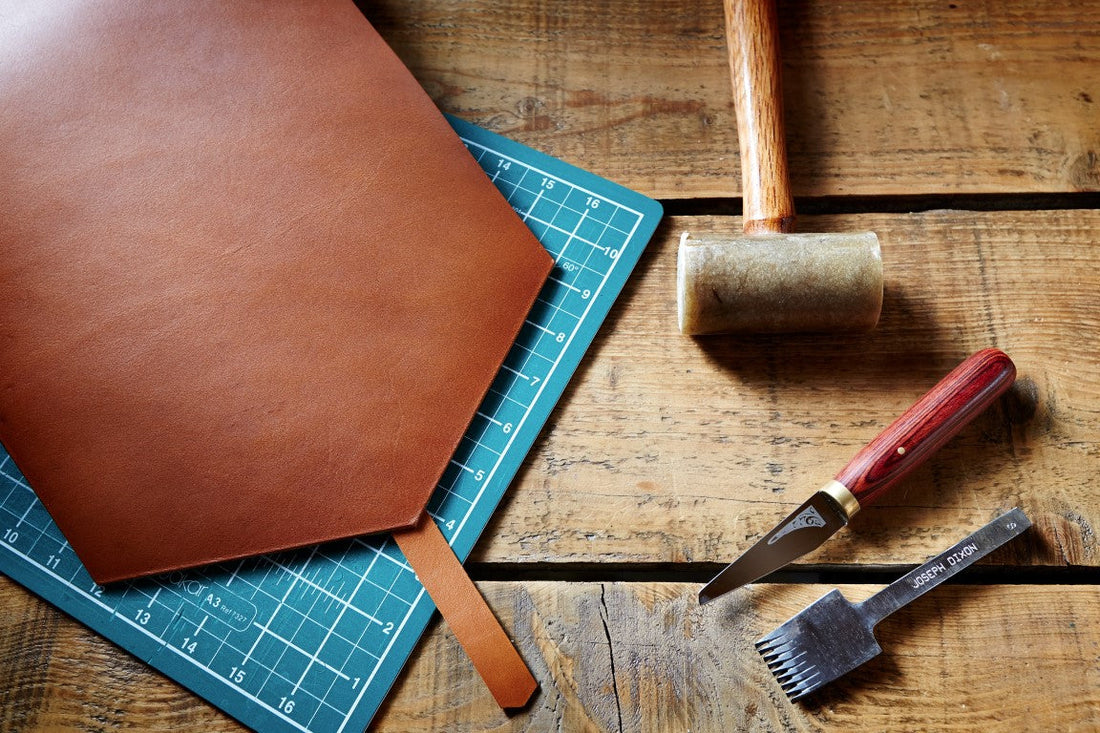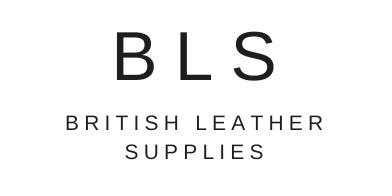
Everything You Need to Know About Leathercraft Tools
Everything You Need to Know About Leathercraft Tools
Whether you're drawn to the timeless appeal of handcrafted leather goods or looking to develop a rewarding new skill, leathercraft offers endless creative possibilities. From wallets and bags to belts and book covers, the art of working with leather combines traditional craftsmanship with practical functionality. However, before you can create beautiful leather pieces, you'll need to understand the essential tools of the trade.
This comprehensive guide will walk you through everything you need to know about leathercraft tools, helping you build a collection that suits your projects and skill level.

Getting Started: The Essential Toolkit
If you're new to leathercraft, the array of available tools can feel overwhelming. The good news is that you don't need every tool to begin your journey. Starting with a carefully selected set of essentials will allow you to learn fundamental techniques whilst keeping your initial investment manageable.
For beginners, a leatherwork starter kit provides an excellent foundation. These curated collections typically include the most frequently used tools, allowing you to begin working on simple projects straight away whilst you develop your skills and discover which specialised tools you'll need as you progress.
Cutting and Preparation Tools
Craft Knives and Rotary Cutters
Precision cutting is fundamental to quality leatherwork. A sharp craft knife with replaceable blades is indispensable for straight cuts, curves, and detail work. Many leather workers prefer knives specifically designed for leather, which feature angled blades that make it easier to achieve clean, precise cuts.
Rotary cutters are excellent for cutting long straight lines and work particularly well with a metal ruler or cutting guide. They're especially useful when cutting straps or preparing multiple pieces of identical size.
Cutting Mats and Rulers
A self-healing cutting mat protects your work surface and provides a stable cutting platform. Look for mats with grid lines to help ensure accurate measurements and straight cuts. Pair your mat with a heavy-duty metal ruler – plastic rulers can be damaged by your knife, potentially ruining your cut and the ruler itself.
Leather Shears
For cutting thicker leather or making rough cuts where precision is less critical, a good pair of leather shears is invaluable. These heavy-duty scissors are designed to handle the density and toughness of leather without straining your hands.
Marking and Measuring Tools
Stitching Chisels and Pricking Irons
Creating evenly spaced stitching holes is crucial for professional-looking results. Stitching chisels (which punch through the leather) and pricking irons (which mark where holes should go) come in various tooth configurations. Common spacing includes 3mm, 4mm, and 5mm between holes.
Diamond-shaped holes, created by diamond chisels, are popular because they create an attractive slanted stitch line and make hand stitching easier.
Wing Dividers and Scratch Compasses
These tools allow you to mark consistent parallel lines along the edge of your leather – essential for positioning stitching lines. Wing dividers are adjustable and lock at your desired width, whilst a scratch compass features a sharp point that scores a visible line into the leather surface.
Edge Bevellers
Before you stitch, bevelling the edges of your leather creates a more refined appearance and removes sharp corners. Edge bevellers come in different sizes to suit various leather thicknesses and are essential for achieving that professional finish.
Hole-Making Tools
Stitching Awls
A stitching awl is used to pierce individual holes in leather and is essential for saddle stitching. The diamond-shaped blade creates holes that guide your needle and thread, ensuring consistent stitch angles. Many leather crafters consider the awl their most important tool.
Hole Punches
Rotary hole punches allow you to create clean, round holes in various sizes – useful for belts, straps, and decorative elements. Individual drive punches are also valuable, particularly for larger holes or when working with thicker leather.
Oblong Punches
For creating slots (such as those needed for buckles), oblong punches are essential. These come in various sizes to accommodate different hardware widths.
Stitching Tools
Needles
Leather needles are blunt-tipped (unlike fabric sewing needles) because you've already created the holes with an awl or chisel. They come in various sizes, with smaller numbers indicating thicker needles. Most projects use needles in the range of size 2 to 5.
Thread
Waxed linen thread and polyester thread are the most common choices for leatherwork. Waxed thread passes through leather more smoothly and the wax helps protect the thread from moisture and abrasion. Thread thickness should match your project – heavier leather requires thicker thread.
Stitching Pony or Clam
Holding your work whilst stitching with both hands requires a stitching pony (also called a stitching horse) or clam. These devices grip your leather, leaving both hands free to stitch. A stitching pony is particularly useful for larger projects and makes saddle stitching significantly easier.
Edge Finishing Tools
Edge Slickers and Burnishers
Finishing the edges of your leather gives your work a polished, professional appearance. Edge slickers (also called burnishers) smooth and seal the edge fibres through friction and heat. These come in various materials including wood, bone, and plastic, each offering different results.
Sandpaper and Abrasives
Before burnishing, you'll often need to sand your edges smooth. Start with coarser grits (around 220) and work your way to finer grits (600 or higher) for the smoothest results.
Edge Paint and Dye
For certain projects and leather types, edge paint provides a crisp, coloured finish. This is particularly popular for bag making and formal leather goods. Edge dye offers a more subtle alternative that enhances the leather's natural appearance.
Stamping and Decorating Tools
Leather Stamps
Leather stamps allow you to create decorative patterns and textures on your work. These metal tools are struck with a mallet to impress designs into dampened leather. From geometric patterns to floral motifs, stamps offer endless creative possibilities.
Swivel Knife
For more intricate decorative work, a swivel knife cuts design lines into the leather surface. This technique, called carving or tooling, creates stunning raised and lowered areas that can be further enhanced with stamps and dyes.
Mallets
A rawhide or nylon mallet is essential for striking stamps, chisels, and punches. These materials won't damage your tools the way a metal hammer would, and they provide good control over striking force.
Finishing and Assembly Tools
Edge Bevellers
As mentioned earlier, bevellers smooth and round the sharp edges of cut leather, creating a more refined appearance and making the leather more comfortable to handle.
Glue and Adhesives
Contact cement designed for leather is used to bond pieces before stitching. This keeps everything aligned whilst you work and adds strength to your finished piece. Apply glue to both surfaces, allow it to dry until tacky, then press together firmly.
Groovers
A groover cuts a shallow channel along the edge of your leather, allowing stitches to sit below the surface. This protects the thread from abrasion and creates a cleaner appearance.
Bone Folders
This smooth, flat tool is used to crease leather, flatten seams, and work dye or finish into edges. Despite the name, modern bone folders may be made from actual bone, Teflon, or plastic.
Advanced and Specialised Tools
As you develop your skills, you may want to invest in more specialised equipment:
Skiving Knives: These thin the edges of leather so they can be folded or overlapped without creating excessive bulk.
Edge Creaser: Creates decorative lines parallel to the edge of your work, adding a professional touch.
Pricking Wheels: Roll along the leather to mark evenly spaced stitching holes, faster than using a chisel for long seams.
Leather Splitter: For thinning entire pieces of leather to your desired thickness.
Press and Dies: For high-volume production, these allow you to cut multiple identical pieces quickly and accurately.
Maintaining Your Tools
Quality leathercraft tools represent a significant investment, but with proper care, they'll last for decades. Keep cutting tools sharp through regular honing and stropping. Clean tools after use to prevent leather residue build-up, and apply a light coat of oil to metal surfaces to prevent rust. Store tools in a dry environment, preferably in a tool roll or box that protects edges and points.
Building Your Collection
You don't need to purchase everything at once. Begin with the essentials – a good knife, ruler, cutting mat, awl, needles, thread, and edge finishing tools. As you complete projects and identify which techniques you enjoy most, gradually add specialised tools to your collection.
Many suppliers, including British Leather Supplies, offer starter kits that provide excellent value for beginners whilst ensuring you have compatible, quality tools to begin your journey.
Conclusion
Leathercraft tools are an investment in your creative future. Whilst the initial array of available tools might seem daunting, remember that even master craftspeople started with just the basics. Focus on learning proper technique with essential tools before expanding your collection, and always prioritise quality over quantity – a few well-made tools will serve you better than a drawer full of inferior ones.
As you develop your skills and discover your preferred leatherworking style, your toolkit will naturally evolve to support your ambitions. Whether you're crafting simple projects or working towards complex creations, having the right tools makes the journey more enjoyable and your results more satisfying.
The world of leathercraft awaits – all you need is a sharp knife, some quality leather, and the willingness to learn. Everything else will follow in good time.
--------------------
Post authored by Becky Cocker, leather artisan and owner of British Leather Supplies. If you'd like to explore a curated selection of quality leather tools and supplies, check out our leather craft tool collection at British Leather Supplies. We’re here to help you take your leatherworking skills to the next level.
